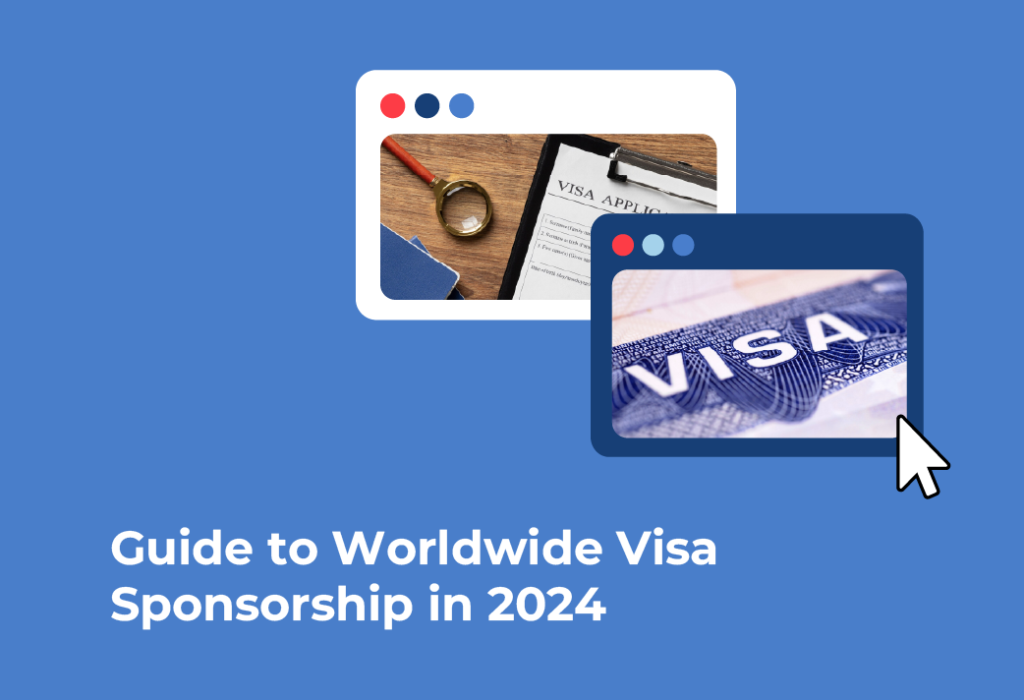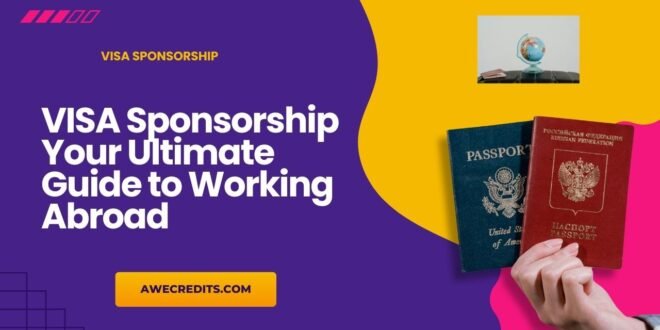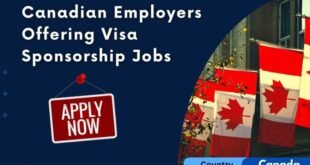If you’re a foreign national seeking to live, work, or study in another country, chances are you will need visa sponsorship. Whether you’re an employee looking to secure a job abroad or an employer considering sponsoring a foreign worker, it’s important to understand what visa sponsorship is, how it works, and the steps involved. This guide is here to answer your questions and help you navigate the visa sponsorship process with ease.
You May Also Like:

What is Visa Sponsorship?
Visa sponsorship is a process that allows foreign nationals to enter and work legally in a country with the support of an employer, family member, or educational institution. A sponsor takes responsibility for your visa application, ensuring all documentation is submitted and that you meet the legal requirements.
For employees, visa sponsorship is essential when you want to work in a country where you don’t have citizenship or permanent residency. If you’re an employer, sponsoring a worker can help you bring in talented individuals from abroad to fill roles that may be difficult to fill locally.
Types of Visa Sponsorships: Which One Do You Need?
Visa sponsorship is not one-size-fits-all. Depending on your purpose for staying in the country, you’ll need different types of sponsorship. Here’s an overview of the most common types:
1. Employment-Based Visa Sponsorship
This is the most common form of visa sponsorship. It allows employers to hire foreign workers to fill specific job roles. Certain countries have special visa programs for skilled professionals, making it easier for businesses to hire globally.
Example Programs:
- H-1B Visa (USA): For highly skilled professionals in fields like technology and healthcare.
- Skilled Worker Visa (Canada): Allows skilled professionals to immigrate to Canada based on a job offer.
- Tier 2 General Visa (UK): For non-EU nationals with a job offer in the UK.
2. Family-Based Visa Sponsorship
If you’re looking to join a spouse, child, or dependent parent in another country, family-based visa sponsorship may be your best option. Your family member acts as the sponsor.
Common Family Visa Types:
- Spouse Visa (USA, UK, Canada): Allows married couples to be reunited in the country.
- Dependent Visa: For children or other dependents of a visa holder.
3. Student Visa Sponsorship
For students who wish to study abroad, many educational institutions provide sponsorship through admission offers. While studying, you may also have the option to work part-time, depending on the visa rules.
Common Student Visa Programs:
- F-1 Visa (USA): For international students attending U.S. universities.
- Study Permit (Canada): For full-time students studying at a Canadian institution.
4. Investor/Entrepreneur Visa Sponsorship
Some countries offer visas for entrepreneurs and investors. These visas allow individuals to start a business and self-sponsor their immigration process.
Examples:
- Entrepreneur Visa (UK, USA, Canada): For business owners and investors.
How Does Visa Sponsorship Work?
The visa sponsorship process can seem complex, but it essentially involves two main parties: the sponsor (usually an employer) and the applicant (the worker or family member). Here’s a breakdown of the process:
For Employers: Steps to Sponsor a Worker
If you’re an employer who wants to sponsor a foreign worker, here’s what you need to do:
- Offer a Job: The employee must receive a formal job offer, which meets the requirements for a specific visa program (like H-1B or Tier 2).
- Submit a Petition: As the sponsor, you submit a petition to the country’s immigration authorities, proving that the foreign worker is needed for the role.
- Labor Market Test: Some countries require you to prove that no qualified local candidates are available for the job.
- Visa Application: Once the petition is approved, the worker applies for their visa using the sponsor’s information.
- Compliance: As the employer, you must maintain compliance with visa regulations, such as ensuring the employee is working in the right role and location.
For Employees: Steps to Apply for Visa Sponsorship
If you’re an employee seeking a visa sponsorship, here’s what you need to do:
- Find a Job with Sponsorship: Look for employers offering jobs that provide visa sponsorship. Job boards like Indeed, LinkedIn, and company career pages often list opportunities.
- Meet Eligibility Requirements: Ensure you meet the job requirements, including education, skills, and sometimes language proficiency.
- Receive the Job Offer: Once an offer is made, your employer will begin the visa sponsorship process.
- Gather Documentation: You’ll need to submit documents such as academic transcripts, proof of employment history, and your passport.
- Visa Application: With your employer’s support, you’ll apply for your visa and may need to attend an interview.
- Receive Visa Approval and Relocate: Once your visa is approved, you can start planning your move and employment.
What are the Benefits of Visa Sponsorship?
For Employers:
- Access to a Global Talent Pool: Visa sponsorship allows you to hire highly skilled workers from around the world, which is particularly valuable when there are local talent shortages.
- Filling Hard-to-Find Roles: Certain industries, such as technology and healthcare, often face a lack of qualified workers. Sponsoring foreign talent can help fill these gaps.
- Diversify Your Workforce: International employees bring diverse perspectives and innovative ideas, fostering a more dynamic work environment.
For Employees:
- Access to Global Opportunities: Visa sponsorship allows you to live and work in countries with better career prospects, better salaries, and career growth opportunities.
- Career Advancement: Working in another country often exposes you to unique learning experiences and career advancement that may not be available in your home country.
- Path to Permanent Residency: Many countries allow workers to transition from temporary work visas to permanent residency or citizenship, which provides long-term stability.
You May Also Like:

Challenges of Visa Sponsorship:
While visa sponsorship offers many benefits, it can come with challenges:
- Long Processing Times: Visa applications can take months, especially if there’s high demand for a particular visa category.
- Visa Denials: Not all visa applications are approved. Applications can be denied for various reasons, including incomplete paperwork or failure to meet eligibility criteria.
- Changing Immigration Policies: Immigration rules often change, which can impact both workers and employers.
- Dependence on Employer: Some visa types tie workers to a specific employer, which means they can lose their visa status if they switch jobs.
Top Countries Offering Visa Sponsorship for Foreign Workers
Countries that are known for offering visa sponsorship opportunities include:
- United States: The H-1B visa program allows skilled workers in specialized fields like technology and healthcare to work in the U.S. Other options include L-1 visas for intra-company transferees.
- Canada: Through its Express Entry and Provincial Nominee Programs, Canada offers visa pathways for skilled workers and those with job offers.
- United Kingdom: The Tier 2 visa allows foreign workers to fill roles that require specific skills, such as IT or healthcare.
- Australia: The Skilled Migration Program offers opportunities for workers in high-demand fields to move to Australia.
Alternatives to Visa Sponsorship
If visa sponsorship isn’t an option for you, consider these alternatives:
- Self-Sponsorship: Countries like the U.S. and UK offer entrepreneur or investor visa programs that allow individuals to sponsor themselves by starting a business.
- Permanent Residency Programs: Some countries, including Canada and Australia, have permanent residency programs that allow foreign workers to eventually gain citizenship without ongoing sponsorship.
- Asylum or Refugee Status: Individuals fleeing conflict or persecution may be eligible for asylum or refugee status, providing an alternate path to residency.
Conclusion: Is Visa Sponsorship Right for You?
Visa sponsorship opens up incredible opportunities for both foreign workers and employers. For employees, it’s a way to gain access to global job markets, improve career prospects, and even move toward permanent residency. For employers, it’s an opportunity to tap into a diverse pool of talented workers and solve skills shortages.
However, the visa sponsorship process involves legal requirements, paperwork, and potentially lengthy processing times. It’s important to be prepared and understand the specific visa rules for the country you wish to work in.
If you’re ready to apply for visa sponsorship, start by researching the right visa type for your needs, identify employers or family members who can act as sponsors, and ensure that you meet the eligibility requirements for a smooth process.
 AWE Credits Free VISA Consultancy Service in USA, UK, UAE, CANADA, Australia
AWE Credits Free VISA Consultancy Service in USA, UK, UAE, CANADA, Australia





